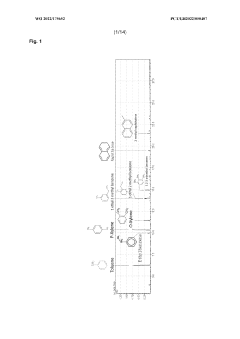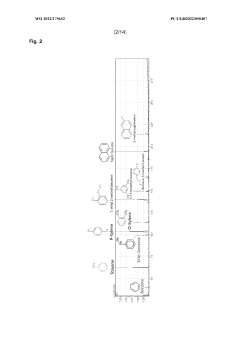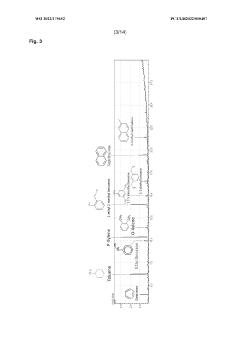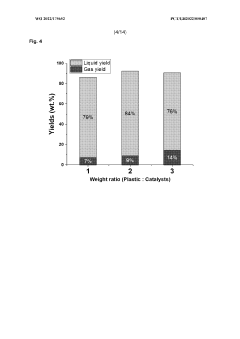Environmental Strategies for HDPE Production Minimization
HDPE Production Background and Objectives
High-density polyethylene (HDPE) production has been a cornerstone of the plastics industry since its commercial introduction in the 1950s. This versatile polymer, known for its high strength-to-density ratio and chemical resistance, has found widespread applications in packaging, construction, and consumer goods. However, the environmental impact of HDPE production has become a growing concern in recent years, prompting a reevaluation of production methods and strategies.
The evolution of HDPE production technology has been marked by significant milestones. Initially, HDPE was produced using Ziegler-Natta catalysts, which revolutionized polyethylene synthesis. Subsequent advancements, such as the development of metallocene catalysts in the 1980s, further improved production efficiency and product quality. Despite these improvements, the energy-intensive nature of HDPE production and its reliance on fossil fuel feedstocks have remained persistent challenges.
Current trends in HDPE production are driven by the dual imperatives of meeting growing global demand and addressing environmental concerns. The global HDPE market, valued at approximately $84 billion in 2020, is projected to reach $101 billion by 2026, underscoring the continued importance of this material. However, this growth trajectory is increasingly at odds with global sustainability goals, necessitating a paradigm shift in production strategies.
The primary objective of environmental strategies for HDPE production minimization is to reduce the overall environmental footprint of the manufacturing process while maintaining or improving product quality and economic viability. This encompasses several key areas of focus: reducing energy consumption, minimizing greenhouse gas emissions, optimizing raw material usage, and exploring alternative feedstocks.
One of the most promising avenues for achieving these objectives is the development of more efficient catalysts and process technologies. Research is ongoing to create catalysts that can operate at lower temperatures and pressures, thereby reducing energy requirements. Additionally, there is growing interest in bio-based feedstocks as a potential alternative to petroleum-derived ethylene, which could significantly reduce the carbon footprint of HDPE production.
Another critical aspect of minimizing HDPE production's environmental impact is the implementation of circular economy principles. This involves not only improving recycling rates for HDPE products but also incorporating recycled content into new HDPE production. Such strategies aim to reduce the demand for virgin HDPE and, by extension, the need for new production capacity.
As the industry moves forward, the challenge lies in balancing technological innovation, economic considerations, and environmental imperatives. The future of HDPE production will likely be shaped by advancements in green chemistry, process intensification, and the integration of renewable energy sources into manufacturing processes. These developments will be crucial in aligning HDPE production with global sustainability goals and ensuring its continued viability in an increasingly environmentally conscious market.
Market Analysis for Eco-friendly HDPE
The market for eco-friendly High-Density Polyethylene (HDPE) has been experiencing significant growth in recent years, driven by increasing environmental awareness and stringent regulations on plastic waste. This surge in demand is reshaping the HDPE industry, pushing manufacturers to adopt more sustainable production methods and develop innovative recycling technologies.
Consumer preferences are shifting towards environmentally responsible products, creating a robust market for eco-friendly HDPE. This trend is particularly evident in packaging, construction, and automotive industries, where HDPE is widely used. Companies are responding by investing in research and development to create bio-based HDPE alternatives and improve recycling processes.
The global eco-friendly HDPE market is expected to continue its upward trajectory, with a compound annual growth rate (CAGR) projected to be substantial over the next five years. This growth is fueled by government initiatives promoting sustainable materials, corporate sustainability goals, and consumer demand for green products.
Key market drivers include the implementation of circular economy principles, which emphasize the importance of recycling and reusing materials. This has led to increased investment in recycling infrastructure and technologies, creating new opportunities for eco-friendly HDPE products. Additionally, the rising cost of virgin HDPE production, coupled with the volatility of oil prices, has made recycled HDPE more economically attractive.
Geographically, Europe and North America are leading the eco-friendly HDPE market, with stringent environmental regulations and well-established recycling programs. However, Asia-Pacific is emerging as a rapidly growing market, driven by increasing environmental concerns and government initiatives in countries like China and India.
The market is characterized by intense competition among major players, who are focusing on developing innovative, sustainable solutions. Collaborations between plastic manufacturers, recycling companies, and end-users are becoming more common, aiming to create closed-loop systems for HDPE production and recycling.
Challenges in the eco-friendly HDPE market include the need for significant investment in new technologies and infrastructure, as well as the current limitations in recycling processes. The quality of recycled HDPE can be inconsistent, which poses challenges for certain high-performance applications. However, ongoing research and technological advancements are addressing these issues, promising to expand the applications of eco-friendly HDPE.
In conclusion, the market analysis for eco-friendly HDPE reveals a sector with strong growth potential, driven by environmental concerns and regulatory pressures. As technology advances and consumer awareness grows, the demand for sustainable HDPE solutions is expected to accelerate, reshaping the plastics industry and opening new opportunities for innovation and market expansion.
Current Challenges in HDPE Production
High-density polyethylene (HDPE) production faces several significant challenges in the current industrial landscape. One of the primary issues is the energy-intensive nature of the manufacturing process. The production of HDPE requires substantial amounts of energy, primarily derived from fossil fuels, contributing to greenhouse gas emissions and environmental degradation. This energy consumption not only impacts the carbon footprint of the industry but also raises concerns about long-term sustainability and compliance with increasingly stringent environmental regulations.
Another critical challenge is the management of raw materials and waste. The production of HDPE relies heavily on petroleum-based feedstocks, which are non-renewable resources. As global oil reserves deplete, the industry faces potential supply chain disruptions and price volatility. Additionally, the production process generates various waste streams, including off-spec materials and process by-products, which require proper disposal or recycling to minimize environmental impact.
Water usage and management present another significant hurdle in HDPE production. The manufacturing process requires substantial amounts of water for cooling and other operational purposes. In regions facing water scarcity, this high water demand can lead to conflicts with local communities and ecosystems. Moreover, the treatment and disposal of wastewater from HDPE production facilities pose environmental risks if not managed properly.
The industry also grapples with the challenge of reducing its overall environmental footprint. This includes addressing issues such as air pollution from volatile organic compound (VOC) emissions, soil contamination from chemical spills, and the long-term environmental persistence of HDPE products. The slow degradation rate of HDPE in natural environments has led to growing concerns about plastic pollution, particularly in marine ecosystems.
Technological limitations in current production methods also contribute to the challenges faced by the HDPE industry. While there have been incremental improvements in process efficiency, breakthrough innovations are needed to significantly reduce the environmental impact of HDPE production. This includes developing more efficient catalysts, exploring alternative feedstocks, and implementing advanced process control systems to optimize resource utilization.
Lastly, the HDPE industry faces increasing pressure from regulatory bodies and public opinion to adopt more sustainable practices. Stricter environmental regulations, carbon pricing mechanisms, and growing consumer demand for eco-friendly products are pushing manufacturers to reevaluate their production processes and seek innovative solutions to minimize their environmental impact. This shift towards sustainability requires significant investments in research and development, as well as potential changes to long-established production methods and supply chains.
Existing HDPE Minimization Strategies
01 Process optimization for HDPE production
Optimizing the HDPE production process can lead to minimization of waste and energy consumption. This includes improving catalyst systems, refining polymerization conditions, and enhancing reactor designs. Advanced control systems and real-time monitoring can help maintain optimal production parameters, reducing overall resource usage and increasing efficiency.- Optimization of polymerization process: Improving the polymerization process for HDPE production can lead to minimization of waste and energy consumption. This includes optimizing reaction conditions, catalyst systems, and process parameters to enhance efficiency and reduce the overall environmental impact of HDPE production.
- Recycling and reuse of HDPE waste: Implementing effective recycling and reuse strategies for HDPE waste can significantly reduce the need for new HDPE production. This involves developing advanced sorting and processing techniques to convert post-consumer HDPE into high-quality recycled material suitable for various applications.
- Use of alternative feedstocks: Exploring and utilizing alternative feedstocks for HDPE production, such as bio-based materials or waste plastics, can help minimize the reliance on traditional petroleum-based resources. This approach can lead to a more sustainable production process and reduced environmental impact.
- Process intensification and equipment optimization: Implementing process intensification techniques and optimizing production equipment can lead to increased efficiency and reduced resource consumption in HDPE manufacturing. This includes the use of advanced reactor designs, improved heat exchange systems, and innovative separation technologies.
- Integration of renewable energy sources: Incorporating renewable energy sources into the HDPE production process can help minimize the carbon footprint and overall environmental impact. This may involve the use of solar, wind, or other clean energy technologies to power production facilities and reduce reliance on fossil fuels.
02 Recycling and reuse of HDPE waste
Implementing effective recycling and reuse strategies for HDPE waste can significantly reduce the need for new production. This involves developing advanced sorting technologies, improving recycling processes, and finding innovative applications for recycled HDPE. By closing the loop in HDPE production, manufacturers can minimize raw material consumption and energy usage.Expand Specific Solutions03 Alternative feedstock for HDPE production
Exploring alternative feedstocks for HDPE production can help minimize the reliance on traditional petroleum-based sources. This includes investigating bio-based materials, utilizing waste plastics as feedstock, and developing novel polymerization techniques that use renewable resources. Such approaches can reduce the environmental impact of HDPE production while maintaining product quality.Expand Specific Solutions04 Energy-efficient production technologies
Implementing energy-efficient technologies in HDPE production can significantly reduce overall energy consumption. This may involve using advanced heat recovery systems, optimizing reactor designs for better heat transfer, and employing energy-efficient equipment throughout the production line. Additionally, integrating renewable energy sources can further minimize the carbon footprint of HDPE production.Expand Specific Solutions05 Lean manufacturing and waste reduction
Applying lean manufacturing principles to HDPE production can help minimize waste and optimize resource utilization. This includes implementing just-in-time production, reducing inventory levels, and streamlining production processes. Additionally, developing strategies for minimizing off-spec product and improving quality control can significantly reduce waste in HDPE production.Expand Specific Solutions
Key Players in Sustainable HDPE Manufacturing
The environmental strategies for HDPE production minimization are at a critical juncture, with the market experiencing steady growth due to increasing demand for sustainable packaging solutions. The global HDPE market is substantial, valued at billions of dollars annually. Technologically, the field is in a mature but evolving stage, with companies like ExxonMobil Upstream Research Co., SABIC Global Technologies BV, and Dow Global Technologies LLC leading innovation. These industry giants are focusing on developing eco-friendly production methods, recycling technologies, and bio-based alternatives. Emerging players such as Braskem SA and Kingfa Sci. & Tech. Co., Ltd. are also making significant strides in sustainable HDPE solutions, indicating a competitive and dynamic landscape driven by environmental concerns and regulatory pressures.
China Petroleum & Chemical Corp.
SABIC Global Technologies BV
Innovative HDPE Reduction Techniques
- A microwave-initiated catalytic process using a bifunctional solid catalyst composition comprising a solid acid catalyst and a carbon source to efficiently upcycle plastics into aromatic compounds, offering high yield and selectivity.
- By mixing calcium carbonate particles of different particle sizes in a specific ratio and filling them with HDPE, lowering the processing temperature, filling HDPE with a mass ratio of 20 to 50%, and performing stearic acid surface treatment, the particle size ratio is 30:70 to 70 :30, the mass ratio of calcium carbonate and HDPE is 30:70~40:60.
Environmental Regulations for Plastics Industry
The plastics industry, particularly the production of High-Density Polyethylene (HDPE), is subject to increasingly stringent environmental regulations worldwide. These regulations aim to mitigate the environmental impact of plastic production and promote sustainable practices throughout the industry.
In the United States, the Environmental Protection Agency (EPA) enforces several key regulations affecting HDPE production. The Clean Air Act mandates strict emission controls for volatile organic compounds (VOCs) and hazardous air pollutants (HAPs) commonly associated with plastic manufacturing processes. Facilities producing HDPE must comply with National Emission Standards for Hazardous Air Pollutants (NESHAP) and implement Maximum Achievable Control Technology (MACT) to minimize air pollution.
The Clean Water Act regulates wastewater discharges from plastic manufacturing facilities, requiring permits and treatment systems to prevent water pollution. The Resource Conservation and Recovery Act (RCRA) governs the management and disposal of hazardous waste generated during HDPE production, emphasizing waste reduction, recycling, and proper disposal practices.
In the European Union, the REACH (Registration, Evaluation, Authorization, and Restriction of Chemicals) regulation plays a crucial role in controlling the use of chemicals in plastic production. HDPE manufacturers must register substances used in their processes and demonstrate their safe use. The Industrial Emissions Directive (IED) sets emission limits and mandates the use of Best Available Techniques (BAT) in plastic production facilities to minimize environmental impact.
Many countries have implemented extended producer responsibility (EPR) programs, which hold manufacturers accountable for the entire lifecycle of their plastic products, including HDPE. These programs incentivize the development of more environmentally friendly production methods and encourage the use of recycled materials in HDPE manufacturing.
Regulations addressing plastic waste and circular economy principles are becoming increasingly prevalent. The EU's Circular Economy Action Plan and similar initiatives worldwide are driving the plastics industry towards more sustainable production models. These regulations often include targets for recycled content in plastic products, which directly impacts HDPE production strategies.
Carbon pricing mechanisms and emissions trading schemes in various regions are also influencing HDPE production. These policies create economic incentives for manufacturers to reduce their carbon footprint and invest in cleaner technologies. As a result, HDPE producers are increasingly focusing on energy efficiency, renewable energy integration, and carbon capture technologies to comply with these regulations and reduce their environmental impact.
Life Cycle Assessment of HDPE Products
Life Cycle Assessment (LCA) is a crucial tool for evaluating the environmental impact of HDPE products throughout their entire lifecycle. This comprehensive approach considers all stages, from raw material extraction to end-of-life disposal, providing valuable insights into the overall sustainability of HDPE production and use.
The LCA process for HDPE products typically begins with the extraction and processing of raw materials, primarily natural gas and petroleum. This stage accounts for a significant portion of the product's environmental footprint, including energy consumption and greenhouse gas emissions associated with drilling, refining, and transportation.
The production phase of HDPE involves polymerization and pelletization processes, which are energy-intensive and contribute to the product's carbon footprint. However, advancements in manufacturing technologies have led to more efficient production methods, reducing energy consumption and emissions over time.
During the use phase, HDPE products generally have a relatively low environmental impact due to their durability and resistance to degradation. This longevity can offset some of the initial production-related impacts, especially when compared to less durable alternatives.
End-of-life considerations are particularly important in the LCA of HDPE products. While HDPE is recyclable, the actual recycling rates vary significantly across regions. Proper recycling can substantially reduce the overall environmental impact by decreasing the need for virgin material production. However, challenges such as contamination and mixed plastic waste streams can hinder recycling efforts.
Incineration and landfilling are alternative end-of-life scenarios that must be considered in a comprehensive LCA. Incineration can recover energy but also produces emissions, while landfilling leads to long-term environmental concerns due to HDPE's slow degradation rate.
Recent LCA studies have highlighted the importance of circular economy principles in improving the environmental performance of HDPE products. Strategies such as design for recyclability, increased use of recycled content, and improved collection and sorting systems can significantly reduce the lifecycle impacts.
Water consumption and pollution are also critical factors in HDPE's LCA, particularly in the extraction and production phases. Efforts to reduce water usage and improve wastewater treatment in these stages can lead to substantial environmental benefits.
By conducting thorough LCAs, manufacturers and policymakers can identify hotspots in the HDPE lifecycle and prioritize interventions for maximum environmental benefit. This approach supports the development of more sustainable production methods, improved product designs, and effective end-of-life management strategies, ultimately contributing to the minimization of HDPE's environmental footprint.



